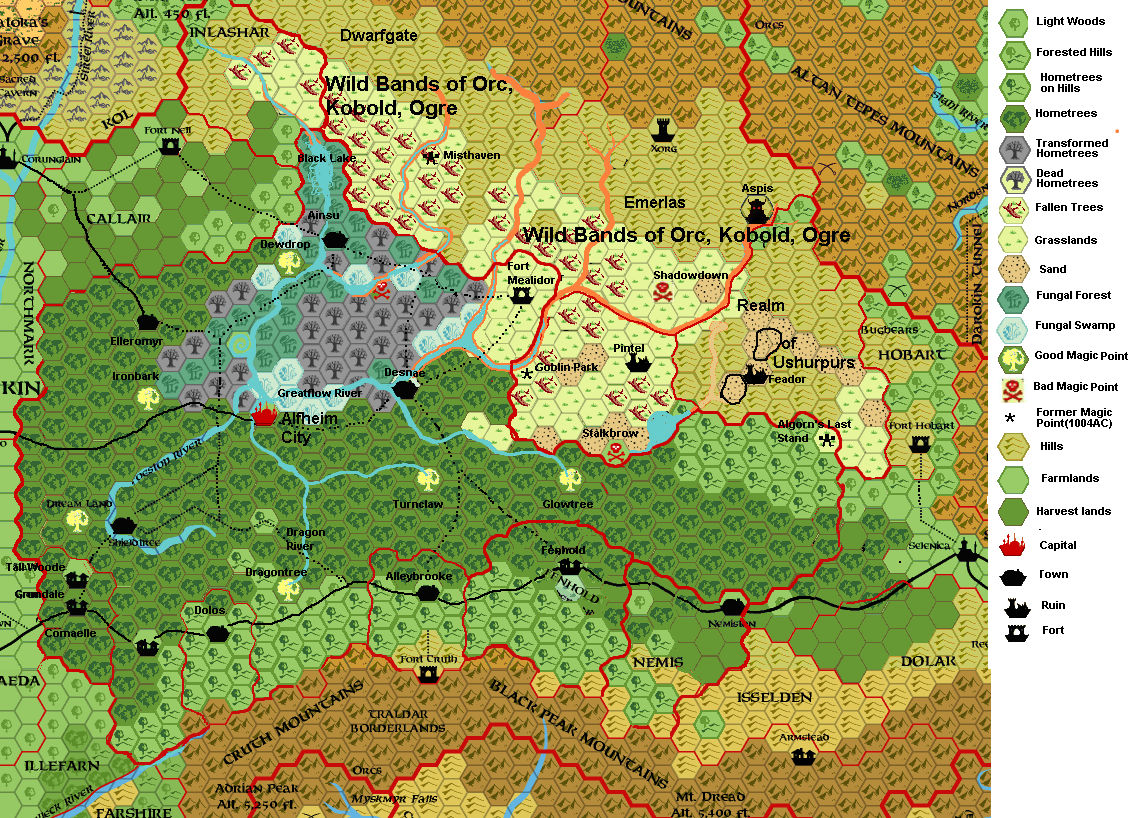
The Demise of the Great Canolbarth Forest (1004-1250 AC)
by RobinCanolbarth forest 1000 AC
This first map in this series is NOT my own work.
But I added it here as the base from which I worked from to create the demise of the Canolbarth Forest.
This map was made by Thorfinn Tait.
Based upon the canon maps of Mystara
Canolbarth forest 1007 AC
This second in the Demise of the Canolbarth is also NOT of my own creation but only used as a base from which I worked upon to create the Canolbarth Forest's demise.
This part was created by Thorfinn Tait, Based upon canon material

Canolbarth forest 1013 AC
This part I created to envision the start of the demise of the Canolbarth Forest of the Alfheim elves after the Shadowelves corrupted the magic used in the creation of this immense forest.
Canolbarth Forest 1013 AC; The Great Drought and lack of rain, are a boon for forest fires, and thus help in the rapid receding of the borders of Canolbarth. The remaining area is mostly full of dead tree trunks, (often harvested by locals for building—the price of wood fell 50%) and mainly grass (like in Ethengar). Political borders have also receded as Shadow Elves have no use of Grassland.
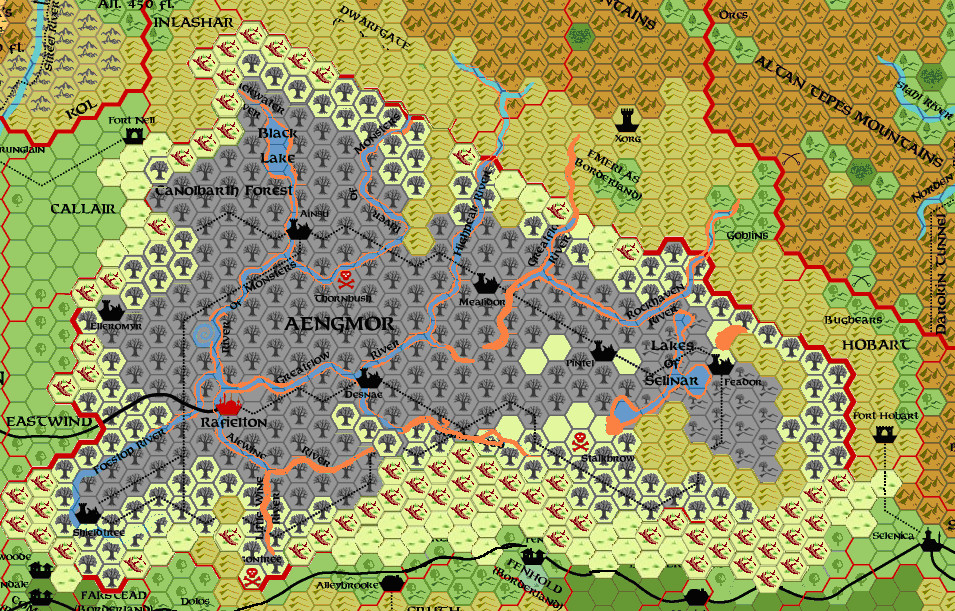
Canolbarth forest 1018 AC
This map is the second map I created to envision the Demise of the Great Canolbarth Forest.
Canolbarth Forest 1018 AC; after Forest Fires, Great Drought and lack of rain. Bad Magic Points become Isolated, but remain Active. Borders have Greatly Receded. This year Dreamland has been reactivated with Grunalf and Shadow Elves cooperation.
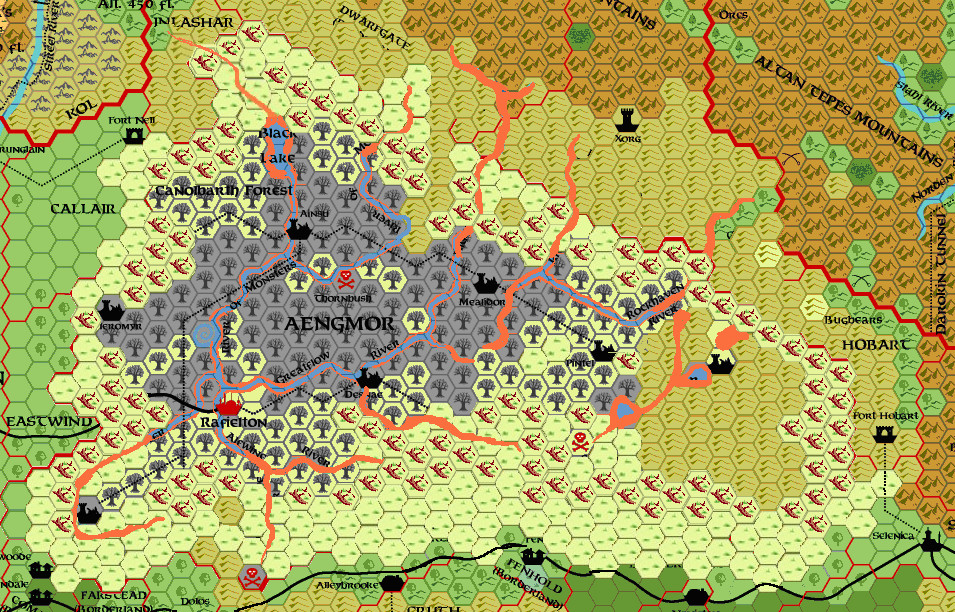
Canolbarth forest 1020 AC
This last map of the former Great Canolbarth Forest shows how the effects of the shadow elven magic destroyed the whole area 1020 AC. The Canolbarth still recedes, yet Ironbark and Dreamland have reignited the forest, yet it is young, and fragile. Fughi slowly take over the wet corupted trees in the darker part of Canolbarth. The shadow Elves have estimated the borders as per 1025 AC, hoping to stop the shrinkage of the Canolbarth there. They also have retaken parts of Woods around Ironbark, but have lost interest in Dreamland
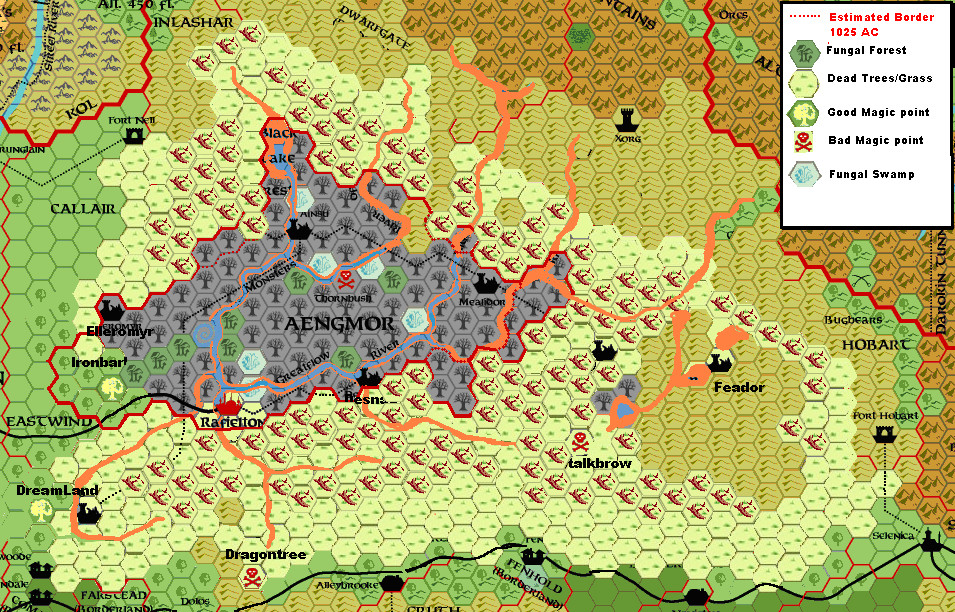
Canolbarth Forest 1100 AC
Estimated Appearance of the Canolbarth Forest region in 1100AC
The Shadow Elves have receded more and more back to their underground realm, They remain hold over the last parts of the Canolbarth Forest, yet the forest continues to decline and fall apart.
The Good Magic Points in the West have increased the regrowth of the area, and new Home Trees (albeit much smaller and younger) have sprung. Due to the water from the Southern mountains new forests have been planted by Alfheim Elves in conjuction with the Darokin Population, and slowly the area becomes greener again.
The Province of New Alfheim is the strongest region of forest regrowth and is populated by Fairykin and returning Alfheim Elves. The growth and expanse of the trees is slow, it will take more centuries until the Canolbarth is back at its former glory.
How the interaction with the Shadow Elves is unkbown, as some bonds are broken, others stretched, while yet others remain firmly in existence. Whatever, the interaction between the Darokinians, Shadowelves and returning Alfheim Elves will be better than expected.
The relation with the negative forces of the region (Ravaging warbands of humanoids in the North, Renegade Dragons and Evil Fairies in the Region between Stalkbrow and Dragontree, and even averse Shadowelves renouncing Rafiel from within the Shadow Elf Community. (Influence of Atzanteotl??)
Many fallen hometrees still lie around, and the funghi have taken root on more locations, yet the old Canolbarth is still shrinking. The magic used to recreate the forest's water resources failed so far, and most water is gone deep within the underground.
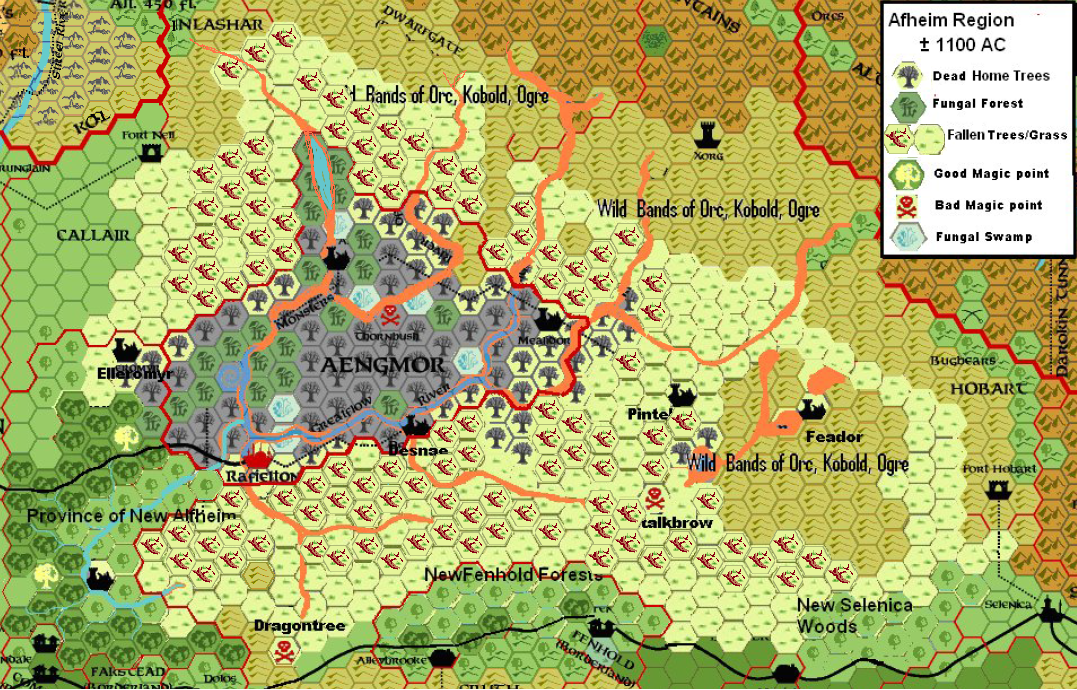
Canolbarth forest 1150 AC
This is a continuation from the line of the Canolbarth Forest. See The Fall and Rise of Canolbarth article in Threshold issue 10 for the full story.
The province is a continuing work of progress between the Alfheim Elves and the Darokinians, and as most of the Shadow Elves have lost their interest in the outer world, they refrain themselves from blocking the regrowth. First and foreall because that the Shadow Elves have discovered that most of their underground water had its origin in the Canolbarth, and that even their vast underground resources are now rapidly diminishing. So they decide to remain mostly absent, and with that they actually promote the regrowth. Unknown to the Alfheim Elves and the Darokinians, they even used their ground magics to refertilize the ground to increase this effect.
All in all the Great Canolbarth will return,....in time. Most Shadow Elves will return to their underground realm, many Alfheim Elves will take root within the new Forest, the Humanoids will be forced back towards the north to the mountains, and most of the region will become somewhat similar to what it was before 1004AC.
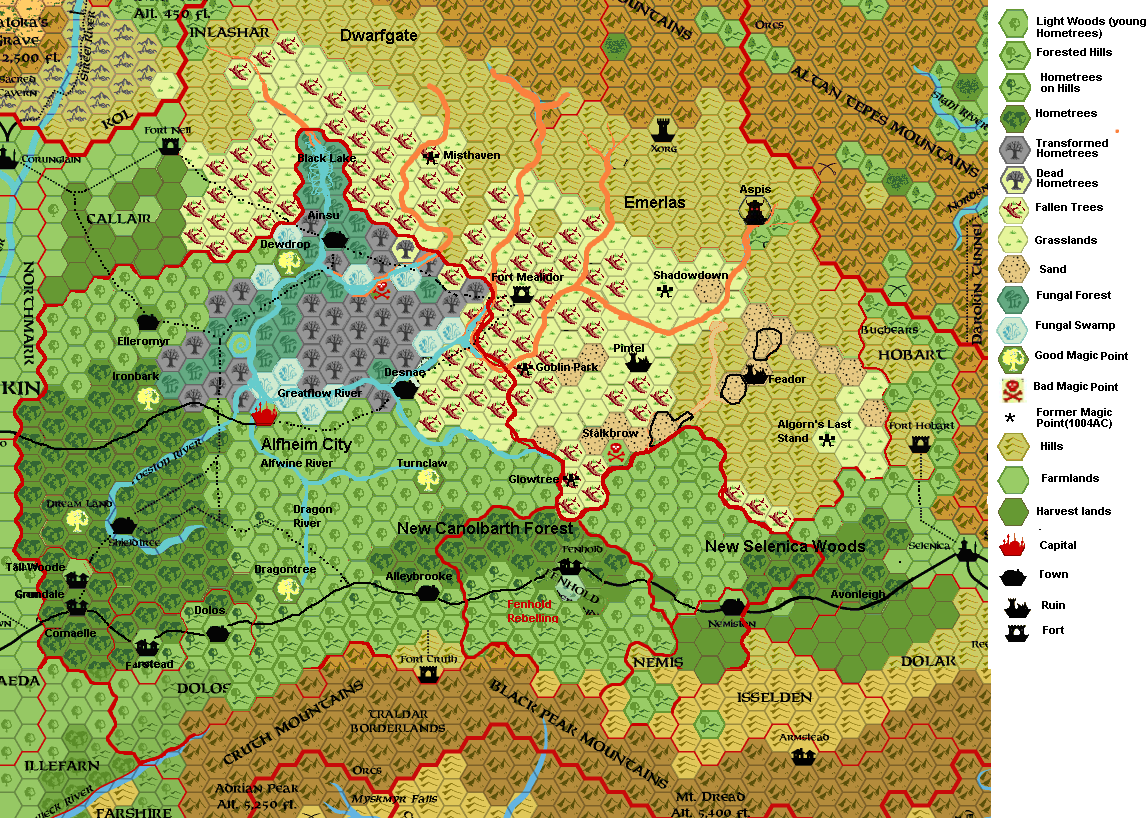
Canolbarth forest future
This is the last in line of this series about the Fall and Rise of the Great Canolbarth Forest of the Alfheim AND Shadow Elves AND Darokinian Humans.
This is somewhere in between 1200 and 1250 AC.
Most of this is now fully explained in the The Fall and Rise of Canolbarth article in Threshold issue 10.
What follows is only an excerpt.
The Darokinians and the two Elven groups have decided to adopt the Elven region within the Borders, politics and commerce of Darokin.
Mutual benefits for all of them have taken the Elves and humans to make this decision.
The Canolbarth has regrown. The trees tower along the crutch mountains, and sometimes the top branches can even be seen between the spires of the mountain chain from Karameikos and the Five Shires. The weather Patterns are full with rain again, except the northern part of Darokin.
The nation changed the Ruins of Mealidor into a strong fort to protect the region from humanoid incursions from the North.
The merging of the Shadow Elves and their altered Hometrees and Fungal forest became balanced. The funghi live like they did in the Underground, or have slightly adapted (to the sun)..
The same happened with the Shadow Elves. All offspring seems to have lost all underground adaptations. The only difference is that they seem to be somewhat pale. As mentioned earlier, these Shadow Elves are free from their ultimate faith of Rafiel, but some still follow it, other follow Elven Faiths of the Alfheim Elves or even the Church of Darokin.
The Dark Elves Hate these Elves more than they hate Alfheim Elves, but their culture of hate and distrust, has caused them to become a loosely tied clutch of small groups within the caves of the Old Broken Lands. They seem to have made links with spiders. And it is rumored that one of these Dark Elves recently became Immortal under the guidance of Atzanteotl, and slowly takes over his faith in this region. Her Symbol seems to be a spider, and her magic was so strange and evil, that she even merged spiders with Dark Elves (Called Driders)
The Deep living Shadow Elves, still have contact and even share commerce with the surface, but blocked all ways to the Broken Lands. They refrain themselves from making contact, and if there is contact, it is mostly a short battle, and than a retreat.
The Darokin Provinces Calair and Inlashar changed. Calair became a region of great produce (probably started by the very fertile ground), while Inlashar, became a border region, with ample protection from the humanoid incursions.
The southern provinces; Dolos, Alleybrooke, Fenhold, Nemis, Corneille have changed significantly. They are now a mixture of Elven and human residents. And they take great benefit from the widened road (8 horses abreast) through the area.
The Elven city Elleromyr became also attached to the Darokin road network, and has a (4 horses abreast road to Corunglain. Just as the Elven capital (which in effect is no more a Capital, but the Elven matters are still ruled here, but now together with Darokinians.), which has a road of 6 horses abreast. Alfheim city is somewhat of a secondary Capital in Darokin, specialized in Elven matters and Nature in common. The Alfheim Part of the Senate includes both Alfheim Elves and former Shadow Elves, and there is even a consulate for the Deep Shadow Elves.
The internal path (and treepaths) havebeen restored and connect the several towns. Typically in the area of trees these paths go up through the trees, while in the regions with funghi and lower structures, these follow over the ground (and sometimes even tunnel short distances (especially near Ainsu and Desnae.).
In the Hills around Feador, a powerful Bugbear King has taken over and raised his personal Kingdom Ushurpurs. (1195 AC)
The Humanoids in the North have succeeded to reactivate the good magical point Shadowdown, and turned its influence to evil. (1190 AC). Making the area more or less like this Dead Forest
Maybe this is because the Elves succeeded themselves, not only to reactivate Turnclaw (1188 AC--unchanged, thus as before decline), Dewdrop(1162 AC--this one creates the moisture for the Funghi nearby), and Glowtree(1164 AC--by reintroducing foreign light giving plants and several colonies of flitterlings), but also Dragontree (1189 AC). The last is now not anymore linked to the Draconic Plane of Chaotic Dragons , but to Neutral Dragons instead (thus becoming a good magic point). Maybe the humanoids succeeded in their goal, due to the continuous balance that the forest needs to remain active.
Stalkbrow is still active with evil Fairies and Goblin Park is still inactive.
The region between Goblin Park and active Stalkbrow, is currently sparsely populated by the Imps, and regular attacks of the nearby Orvc, Ogre and Kobold bands (who have taken hold of the ruins of Pintel). Many large spiders and scorpions live in this whole region, used as mounts for the Imps. Other insects (including large) live here too, feeding upon the remnants of the former Hometrees, being food themselves for the spiders. There is rumor of a single hive of Aspis East of this region near the hills (near the Realm of Ushurpurs), but these refrain themselves from making contact to sentient species (other than for food/tools/slaves). To find more about the Aspis, spiders, scorpions, and other insects read compilation book Monster Manual Lowlife.
The Elves have tried to retake Algorn's Last Stand (since 1192 AC 8 attempts) but sofar failed due to the strategic tactics of the clever Bugbear King.
Humanoids hearing of the succes of Shadowdown currently try to reactivate Misthaven, but they seem to miss the knowledge for this tremendous magical feat, and fail,... every year again, since their first attempt in 1193 AC.
If Shadowdown would ever be reactivated, the wole region here would be clouded in an everlasting moist mistbank (visuals less than 100' ) as before. This would become a great boon to the Funghi. They would rapidly (less than 10 years) replace all the fallen trees and thus enlarge the fungal forest there. the new Canolbarth border would then be pushed further nortwards (almost up to the hills North and East of Misthaven), to the edge of the new forest. However, the area would remain a source of food, predation, hunting to the high number of humanoids there.
If Goblin Park would ever be reactivated, it would become a negative magical point and thus a boon to the humanoids living there. Together with still negative active Stalkbrow, this would increase their hold of this region, becoming a mixture of imps and Humanoids territory.
If Algorn's Last Stand would ever be reactivated it would cause the region a new area of growth, but not trees, but bushes, and low plants. with the demise of the forest, the woodlooting by any nearby, and the take over by Ushurpurs all trees, seeds have completely perished. The region changed forever. However, a "new" magic pouint would still benefit all races (Bugbear, Humans and Elves) in a positive way...maybe even enablng a weird truce... for several years.
The Emerlas would remain Humanoid territory, and never return to the Canolbarth. The area would become darker, with glooming dark shadows everywhere. Darker creatures (like Shadows) would like the area and settle between the humanoids (sometimes preying on them). Fort Mealidor became a strong point of knowledge about these vile (not undead) creatures, and a great point of defence to the inhabitants of the Canolbarth.
In effect there are now 4 sorts of Shadow Elves on Mystara;
Evil Shadow Elves mostly called Dark Elves; Located in Underground in Eastern Broken Lands, Followers of Atzanteotl and New (former Shadow Elf ) Immortal Lolth. Darker skin , lighter Hair, Love for Spiders, Evil, Chaotic. Have Wizards, and Shaman but with restricted spelllist in resemblance to the other Shadow Elves).
Shadow Elves sometimes called Deep Elves; Located in Shadow Elf Underground Territories, Followers of Rafiel. Pale skin, white Hair Clear Eyes (sometimes Purple skin markings) Have Wizards and Shaman.Neutral but a bit Xenophobic.
Surface Shadow Elves sometimes called Pale Elves; In the Canolbarth Forest (especially the Altered Forest and Fungal Forest). Often merging with normal Alfheim Elves. Pale skin, Light hair, but a better teint than the Deep Elves. Darker hairs and green teint of skin like the Alfheim Elves are also more and more common. Slowly adapting to the sun (In about 1 or 2 generations at most this species will have completely merged and be indistinctable to any other surface elves). Followers of Ilsundal and other Surface Elves Immortals, but many also of Rafiel, but much more free and less restricted than the deep elves (it is a declining Faith however). Have Wizards and some Clerics, no Shaman anymore. Neutral and Open.
SchattenAlfen; In the Hollow World, Followers of Atzanteotl.Have Wizards and Clerics. Chaotic and often also Evil.
